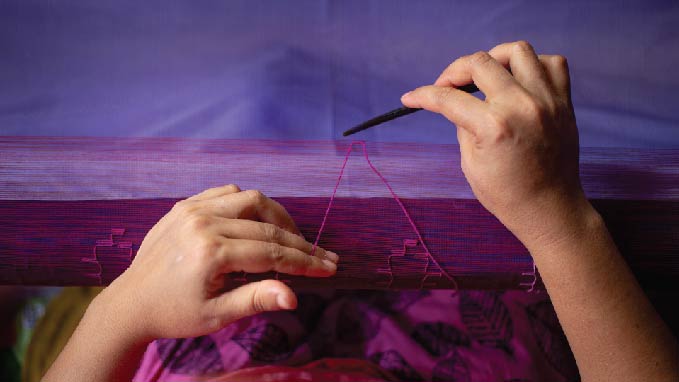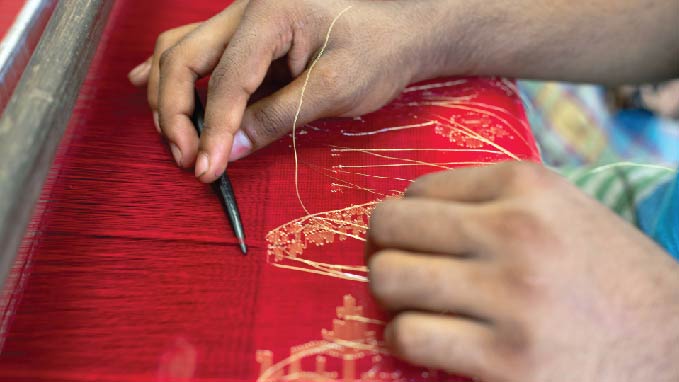Bangladesh's rich textile tapestry spans over a millennium, showcasing delicate Muslin, timeless Tant, and Rajshahi Silk, captivating Manipuri textiles, and more. These traditions inspire endless fashion possibilities, combining heritage and contemporary aesthetics.

Muslin, once the pride of Bengal, enamored the world with its delicate fineness. The ethereal beauty of Muslin remains a timeless testament to Bangladesh's textile heritage, reflecting its mastery and establishing the region as a global hub for textile trade.
Jamdani, renowned for its intricate hand-weaving techniques and exquisite motifs, earned recognition as a UNESCO Intangible Cultural Heritage. Protected by the Geographical Indication (GI) status, Jamdani preserves its unique regional identity and weaving techniques.
Other remarkable textile traditions include Khadi fabric, symbolizing self-sufficiency and resilience, Tant sarees with their lightweight comfort and traditional motifs, opulent Rajshahi Silk, and the artistry of Manipuri textiles, blending local craftsmanship and cultural heritage.
Jamdani, renowned for its intricate hand-weaving techniques and exquisite motifs, earned recognition as a UNESCO Intangible Cultural Heritage. Protected by the Geographical Indication (GI) status, Jamdani preserves its unique regional identity and weaving techniques.
Other remarkable textile traditions include Khadi fabric, symbolizing self-sufficiency and resilience, Tant sarees with their lightweight comfort and traditional motifs, opulent Rajshahi Silk, and the artistry of Manipuri textiles, blending local craftsmanship and cultural heritage.
“ Other remarkable textile traditions include Khadi fabric, symbolizing self-sufficiency and resilience, Tant sarees with their lightweight comfort and traditional motifs, opulent Rajshahi Silk, and the artistry of Manipuri textiles, blending local craftsmanship and cultural heritage. ”
Kantha embroidery, with its intricate stitching and storytelling motifs, adds a touch of artistry to discarded fabrics. Bangladesh also embraces natural fibers like jute, bamboo, and banana, along with natural dyes such as indigo, celebrating sustainability and innovation.
The transformative spirit ignited by the 1971 Liberation War paved the way for Bangladesh's thriving garments industry, combining skilled artisans, entrepreneurship, and sustainable practices.
As Bangladesh solidifies its position as a global apparel powerhouse, the prospects of a heritage-inspired fashion manufacturing sector, particularly in high-end fashion, shining brightly.
The transformative spirit ignited by the 1971 Liberation War paved the way for Bangladesh's thriving garments industry, combining skilled artisans, entrepreneurship, and sustainable practices.
As Bangladesh solidifies its position as a global apparel powerhouse, the prospects of a heritage-inspired fashion manufacturing sector, particularly in high-end fashion, shining brightly.
Related Posts
 45 min ago
45 min ago
Unleashing Heritage: Bangladesh's Journey Towards High-End Fashion Fusion
Bangladesh's rich textile tapestry spans over a millennium, encompassing delicate Muslin, timeless Tant and Rajshahi Silk, captivating Manipuri textiles, and more. These traditions showcase a diverse heritage, inspiring endless fashion possibilities.
 45 min ago
45 min ago
Unleashing Heritage: Captivating Bangladesh's Textile Tapestry in Contemporary Fashion
Bangladesh's rich textile tapestry spans over a millennium, showcasing delicate Muslin, timeless Tant, and Rajshahi Silk, captivating Manipuri textiles, and more. These traditions inspire endless fashion possibilities, combining heritage and contemporary aesthetics.